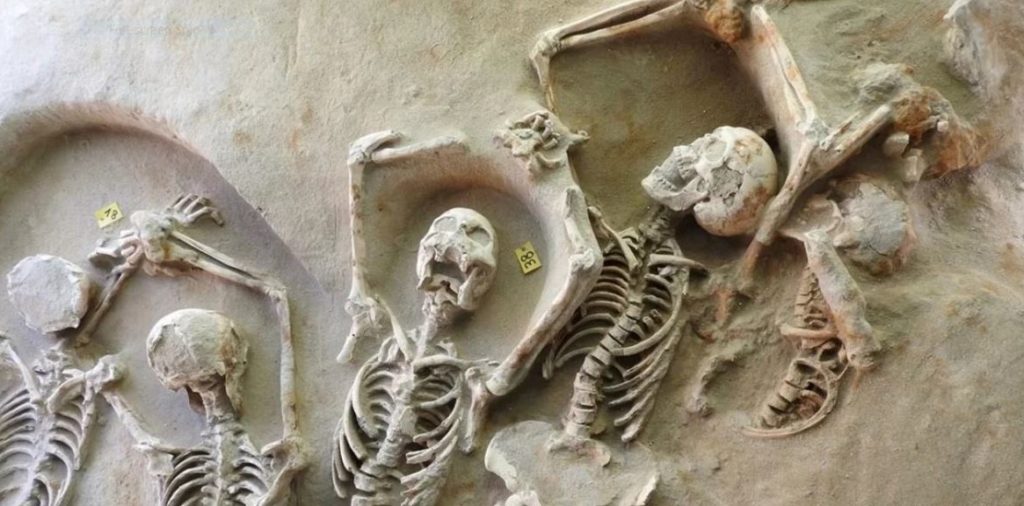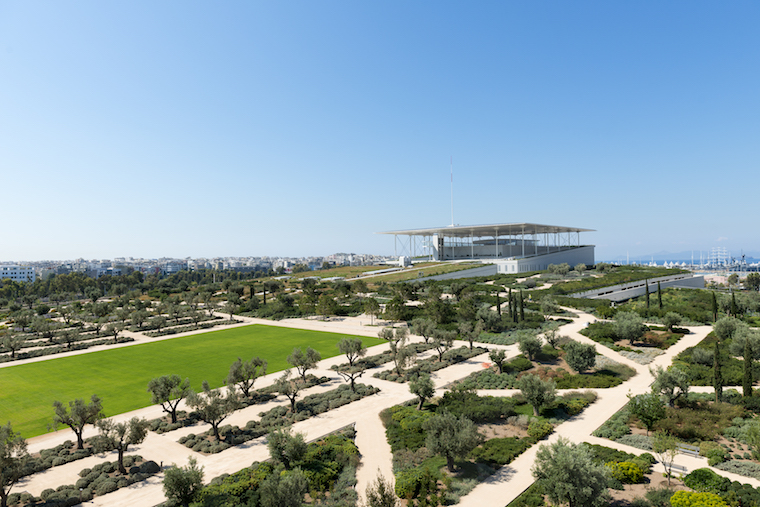
Greek officials signed a deal Wednesday approving a $4.8 million donation to exhibit the findings from the 2016 necropolis discovery that was made as part of the construction of the Stavros Niarchos Foundation Cultural Center (SNFCC).
The donation will finance an exhibition space for the ancient Greek necropolis, discovered at Delta Falirou as construction began for the center in 2016. Finance Minister Christos Staikouras, Deputy Finance Minister Apostolos Vesyropoulos and Culture Minister Lina Mendoni signed the agreement.
The proposed exhibition will be designed by Renzo Piano, the Italian architect who also created the Niarchos Cultural Center as well as the Georges Pompidou Center in Paris, The Shard in London and the Whitney Museum of American Art in New York City.
The donation agreement includes financing the study, construction and supply of equipment of an exhibition building, referred to as the Polyandri Shell for the amount of $4.8 million. Niarchos Foundation President, Andreas Drakopoulos, announced that the exhibition will be designed by Piano, the Renaissance architect.
The shell which will permanently protect and display the 80 skeletons discovered in 2016 in a mass grave in an ancient Greek cemetery, south of Athens.
A necropolis is a huge burial location for the dead, often comprised of elaborate temples with ornate tombs and monuments. The name stems from ancient Greek literally meaning “city of the dead.”
Necropolis Desmotes Discovered During SNFCC Construction
With wrists still bound by iron shackles, the skeletons were found in the Delta Faliron necropolis during the construction of SNFCC. The grisly find was actually a rare and extraordinary one, which was hailed as one of the ten most important archaeological discoveries of 2016 by the respected US periodical Archaeology.
According to archaeologists, the men, also referred to as “desmotes,” had been victims of a mass execution at some point between the eighth and fifth centuries BC. But who the men were, how they got there and why they appear to have been buried with a measure of respect remains a mystery.
Polyandri for Necropolis to Follow KAS Guidelines
Two years earlier the Central Archaeological Council (KAS) decided to construct the underground shell which will permanently protect and display the 80 skeletons discovered in 2016 in the mass grave.
Stella Chrysoulaki, Director of the Ephorate of Antiquities of Piraeus and Islands, who is responsible for the excavation, stated, “Nothing macabre will be created in image or experience.” With the approval of the donation “The next steps are clear, but it will take time to complete each stage. Renzo Piano will begin planning and will probably travel to Greece this summer to review the site.” Piano refers to SNFCC as the “Bella Vista.”

Archaeological evidence showed that they were men who were on the wrong side of a huge struggle between aristocrats and tyrants in seventh-century BC Athens.
The date may connect the prisoners with the Cylonian Affair, in which Cylon, a former Olympic athlete, attempted unsuccessfully to seize power. It is thought that these shackled men may have been his supporters.
Cylon staged an attempted coup in Athens in 632 BC with the help of his father-in–law, the tyrant of Megara. The coup failed, and Cylon then hid inside a temple on the Acropolis. He later managed to escape, but the people who had backed him were killed.
The KAS wants to turn the necropolis into an accessible site for public education and tours. The graves will be covered by the construction of a simple, plain underground shell which will blend tastefully with the surrounding landscape.
The shell will have to also provide just the right microclimate for the preservation of the skeletons, in accordance with environmental requirements. The project will be architecturally simple and plain and will seek to instill a sense that visitors are going downward into a respectful resting place for the dead.
The Polyandrio specifications have already been determined by the CAS. An information space will be created for the public at ground level before the visitors descend one story to an 11,000 square foot basement space where the graves can be viewed.
Necroplis Burial Ground First Excavated by Stratis Pelekidis
Chrysoulaki stated “The cemetery of Faliro is located in the southern extremities of the city, on the border between land and sea, between familiar and unfamiliar, for departure, separation, for the passage from life to death.”
The necropolis of Faliro functioned for four centuries during the archaic period. To date, 10 acres have been excavated which yielded about 2,000 burials. In fact, the first phase of the excavations began in 1911 and 1915 by the Archaeological Society led by Stratis Pelekidis, who located the first burials of people who had died violently.
“Pelekidis’ systematic work, his persistence, the fact that he even collaborated with an anthropologist, were crucial for the continuation of the excavations and the revelation of the great historical truth about the tortures of the young men,” according to Chrysoulakis.
“Pelekidis then brought to light a dark page that history wanted to forget, the Fallen of Faliro. These were the skeletons of men who were sentenced to death and tortured to death. In 1915, political leadership and not only could not stand the idea of such humiliating deaths that gave a dimension that did not fit the narrative of the Republic.”
See all the latest news from Greece and the world at Greekreporter.com. Contact our newsroom to report an update or send your story, photos and videos. Follow GR on Google News and subscribe here to our daily email!



